I'm trying to record my app's screen using ReplayKit, cropping out some parts of it while recording the video. Not quite going well.
ReplayKit will capture the entire screen, so I decided to receive each frame from ReplayKit (as CMSampleBuffer via startCaptureWithHandler), crop it there and feed it to a video writer via AVAssetWriterInputPixelBufferAdaptor. But I am having a trouble in hard-copying the image buffer before cropping it.
This is my working code that records the entire screen:
// Starts recording with a completion/error handler
-(void)startRecordingWithHandler: (RPHandler)handler
{
// Sets up AVAssetWriter that will generate a video file from the recording.
self.writer = [AVAssetWriter assetWriterWithURL:self.outputFileURL
fileType:AVFileTypeQuickTimeMovie
error:nil];
NSDictionary* outputSettings =
@{
AVVideoWidthKey : @(screen.size.width), // The whole width of the entire screen.
AVVideoHeightKey : @(screen.size.height), // The whole height of the entire screen.
AVVideoCodecKey : AVVideoCodecTypeH264,
};
// Sets up AVAssetWriterInput that will feed ReplayKit's frame buffers to the writer.
self.videoInput = [AVAssetWriterInput assetWriterInputWithMediaType:AVMediaTypeVideo
outputSettings:outputSettings];
// Lets it know that the input will be realtime using ReplayKit.
[self.videoInput setExpectsMediaDataInRealTime:YES];
NSDictionary* sourcePixelBufferAttributes =
@{
(NSString*) kCVPixelBufferPixelFormatTypeKey: @(kCVPixelFormatType_32BGRA),
(NSString*) kCVPixelBufferWidthKey : @(screen.size.width),
(NSString*) kCVPixelBufferHeightKey : @(screen.size.height),
};
// Adds the video input to the writer.
[self.writer addInput:self.videoInput];
// Sets up ReplayKit itself.
self.recorder = [RPScreenRecorder sharedRecorder];
// Arranges the pipleline from ReplayKit to the input.
RPBufferHandler bufferHandler = ^(CMSampleBufferRef sampleBuffer, RPSampleBufferType bufferType, NSError* error) {
[self captureSampleBuffer:sampleBuffer withBufferType:bufferType];
};
RPHandler errorHandler = ^(NSError* error) {
if (error) handler(error);
};
// Starts ReplayKit's recording session.
// Sample buffers will be sent to `captureSampleBuffer` method.
[self.recorder startCaptureWithHandler:bufferHandler completionHandler:errorHandler];
}
// Receives a sample buffer from ReplayKit every frame.
-(void)captureSampleBuffer:(CMSampleBufferRef)sampleBuffer withBufferType:(RPSampleBufferType)bufferType
{
// Uses a queue in sync so that the writer-starting logic won't be invoked twice.
dispatch_sync(dispatch_get_main_queue(), ^{
// Starts the writer if not started yet. We do this here in order to get the proper source time later.
if (self.writer.status == AVAssetWriterStatusUnknown) {
[self.writer startWriting];
return;
}
// Receives a sample buffer from ReplayKit.
switch (bufferType) {
case RPSampleBufferTypeVideo:{
// Initializes the source time when a video frame buffer is received the first time.
// This prevents the output video from starting with blank frames.
if (!self.startedWriting) {
NSLog(@"self.writer startSessionAtSourceTime");
[self.writer startSessionAtSourceTime:CMSampleBufferGetPresentationTimeStamp(sampleBuffer)];
self.startedWriting = YES;
}
// Appends a received video frame buffer to the writer.
[self.input append:sampleBuffer];
break;
}
}
});
}
// Stops the current recording session, and saves the output file to the user photo album.
-(void)stopRecordingWithHandler:(RPHandler)handler
{
// Closes the input.
[self.videoInput markAsFinished];
// Finishes up the writer.
[self.writer finishWritingWithCompletionHandler:^{
handler(self.writer.error);
// Saves the output video to the user photo album.
[[PHPhotoLibrary sharedPhotoLibrary] performChanges: ^{ [PHAssetChangeRequest creationRequestForAssetFromVideoAtFileURL: self.outputFileURL]; }
completionHandler: ^(BOOL s, NSError* e) { }];
}];
// Stops ReplayKit's recording.
[self.recorder stopCaptureWithHandler:nil];
}
where each sample buffer from ReplayKit will be directly fed to the writer (in captureSampleBuffer method), hence records the entire screen.
Then, I replaced the part with an identical logic using AVAssetWriterInputPixelBufferAdaptor, which works just fine:
...
case RPSampleBufferTypeVideo:{
... // Initializes source time.
// Gets the timestamp of the sample buffer.
CMTime time = CMSampleBufferGetPresentationTimeStamp(sampleBuffer);
// Extracts the pixel image buffer from the sample buffer.
CVPixelBufferRef imageBuffer = CMSampleBufferGetImageBuffer(sampleBuffer);
// Appends a received sample buffer as an image buffer to the writer via the adaptor.
[self.videoAdaptor appendPixelBuffer:imageBuffer withPresentationTime:time];
break;
}
...
where the adaptor is set up as:
NSDictionary* sourcePixelBufferAttributes =
@{
(NSString*) kCVPixelBufferPixelFormatTypeKey: @(kCVPixelFormatType_32BGRA),
(NSString*) kCVPixelBufferWidthKey : @(screen.size.width),
(NSString*) kCVPixelBufferHeightKey : @(screen.size.height),
};
self.videoAdaptor = [AVAssetWriterInputPixelBufferAdaptor assetWriterInputPixelBufferAdaptorWithAssetWriterInput:self.videoInput
sourcePixelBufferAttributes:sourcePixelBufferAttributes];
So the pipeline is working.
Then, I created a hard copy of the image buffer in the main memory and feed it to the adaptor:
...
case RPSampleBufferTypeVideo:{
... // Initializes source time.
// Gets the timestamp of the sample buffer.
CMTime time = CMSampleBufferGetPresentationTimeStamp(sampleBuffer);
// Extracts the pixel image buffer from the sample buffer.
CVPixelBufferRef imageBuffer = CMSampleBufferGetImageBuffer(sampleBuffer);
// Hard-copies the image buffer.
CVPixelBufferRef copiedImageBuffer = [self copy:imageBuffer];
// Appends a received video frame buffer to the writer via the adaptor.
[self.adaptor appendPixelBuffer:copiedImageBuffer withPresentationTime:time];
break;
}
...
// Hard-copies the pixel buffer.
-(CVPixelBufferRef)copy:(CVPixelBufferRef)inputBuffer
{
// Locks the base address of the buffer
// so that GPU won't change the data until unlocked later.
CVPixelBufferLockBaseAddress(inputBuffer, 0); //-------------------------------
char* baseAddress = (char*)CVPixelBufferGetBaseAddress(inputBuffer);
size_t bytesPerRow = CVPixelBufferGetBytesPerRow(inputBuffer);
size_t width = CVPixelBufferGetWidth(inputBuffer);
size_t height = CVPixelBufferGetHeight(inputBuffer);
size_t length = bytesPerRow * height;
// Mallocs the same length as the input buffer for copying.
char* outputAddress = (char*)malloc(length);
// Copies the input buffer's data to the malloced space.
for (int i = 0; i < length; i++) {
outputAddress[i] = baseAddress[i];
}
// Create a new image buffer using the copied data.
CVPixelBufferRef outputBuffer;
CVPixelBufferCreateWithBytes(kCFAllocatorDefault,
width,
height,
kCVPixelFormatType_32BGRA,
outputAddress,
bytesPerRow,
&releaseCallback, // Releases the malloced space.
NULL,
NULL,
&outputBuffer);
// Unlocks the base address of the input buffer
// So that GPU can restart using the data.
CVPixelBufferUnlockBaseAddress(inputBuffer, 0); //-------------------------------
return outputBuffer;
}
// Releases the malloced space.
void releaseCallback(void *releaseRefCon, const void *baseAddress)
{
free((void *)baseAddress);
}
This doesn't work -- the saved video will look like the screenshot on the right hand:

Seems like bytes per row and the color format are wrong. I have researched and experimented with the followings, but not avail:
- Hard-coding
4 * widthfor bytes per row -> "bad access". - Using
intanddoubleinstead ofchar-> some weird debugger-terminating exceptions. - Using other image formats -> either "not supported" or access errors.
Additionally, the releaseCallback is never called -- the ram will run out in 10 seconds of recording.
What are potential causes from the look of this output?